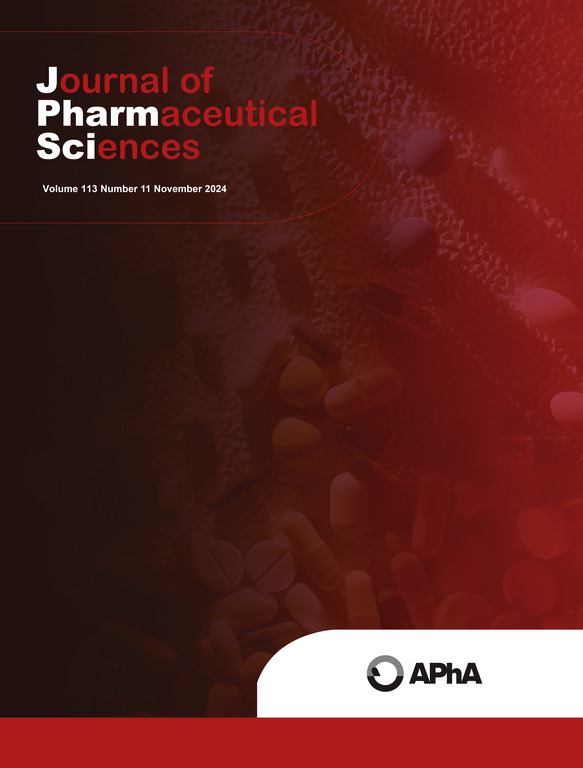A high-throughput micro-scale workflow to quantify molecularly dissolved drug concentrations under solubilizing conditions
IF 3.7
3区 医学
Q2 CHEMISTRY, MEDICINAL
引用次数: 0
Abstract
Physiological and artificial solubilizing agents usually enhance apparent solubility of poorly soluble drugs, and in many cases also oral drug exposure. However, exposure may decrease in cases where micellization reduces the molecularly dissolved drug fraction, overriding the solubility advantage. While this information is critical to accurately anticipate the effect of drug micellization on oral absorption, the experimental determination of molecularly dissolved drug concentrations is complex and time consuming.
The present study aimed at developing a micro-scale in vitro workflow (comparative micro-scale mass transfer assay, CMMTA) to quantify molecularly dissolved (unbound) drug concentrations in the presence of solubilizing agents.
A linear correlation was determined between the cumulative passive permeation of the model drug riluzole (RLZ) and its concentration in the donor buffer solution on a 96-well microtiter sandwich plate (PermeaPlain™). Next, the drug permeation from micellar drug solutions (in fasted and fed state simulated intestinal fluids, FaSSIF and FeSSIF) was measured and the concentration of unbound drug was derived from the aforementioned correlation. The results were validated against established methods to measure free (unbound) drug concentrations, namely equilibrium dialysis and microdialysis. The concentrations of molecularly dissolved RLZ were correctly captured on one single microtiter plate.
Both, the standard curve and samples at different solubilizing conditions can be determined simultaneously within a few hours using small quantities of drug substance. Hence, the proposed CMMTA workflow represents a promising screening tool for early-stage drug development.

在增溶条件下定量分子溶解药物浓度的高通量微尺度工作流程。
生理增溶剂和人工增溶剂通常会提高难溶性药物的表观溶解度,在许多情况下也会增加口服药物暴露。然而,在胶束作用减少分子溶解药物部分的情况下,暴露可能会减少,这压倒了溶解度优势。虽然这些信息对于准确预测药物胶束化对口服吸收的影响至关重要,但分子溶解药物浓度的实验测定既复杂又耗时。本研究旨在开发一种微尺度体外工作流程(比较微尺度传质法,CMMTA),以量化在增溶剂存在下的分子溶解(未结合)药物浓度。在96孔微滴夹心板(PermeaPlain™)上测定模型药物利鲁唑(RLZ)的累积被动渗透与其在供体缓冲溶液中的浓度之间的线性相关。接下来,测量胶束药物溶液(禁食状态和进食状态模拟肠液,FaSSIF和FeSSIF)的药物渗透,并根据上述相关性得出未结合药物的浓度。结果验证了建立的方法来测量游离(未结合)药物浓度,即平衡透析和微透析。分子溶解RLZ的浓度被正确地捕获在一个微滴板上。使用少量原料药,可在数小时内同时测定不同溶解条件下的标准曲线和样品。因此,拟议的CMMTA工作流程代表了早期药物开发的有前途的筛选工具。
本文章由计算机程序翻译,如有差异,请以英文原文为准。
求助全文
约1分钟内获得全文
求助全文
来源期刊
CiteScore
7.30
自引率
13.20%
发文量
367
审稿时长
33 days
期刊介绍:
The Journal of Pharmaceutical Sciences will publish original research papers, original research notes, invited topical reviews (including Minireviews), and editorial commentary and news. The area of focus shall be concepts in basic pharmaceutical science and such topics as chemical processing of pharmaceuticals, including crystallization, lyophilization, chemical stability of drugs, pharmacokinetics, biopharmaceutics, pharmacodynamics, pro-drug developments, metabolic disposition of bioactive agents, dosage form design, protein-peptide chemistry and biotechnology specifically as these relate to pharmaceutical technology, and targeted drug delivery.

 求助内容:
求助内容: 应助结果提醒方式:
应助结果提醒方式:


